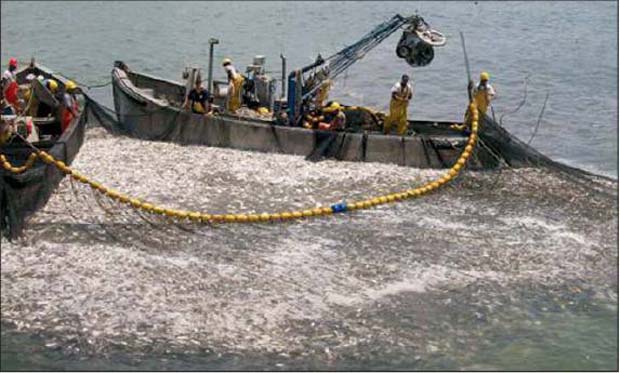By Ken Hinman
 [dropcap]A[/dropcap]re Atlantic menhaden “overfished” or not? For the most important fish in the sea, that’s not what’s most important. What matters for menhaden and other forage species is whether or not we are leaving enough fish in the water to serve their vital role in the ecosystem. And we aren’t. Even the most optimistic scenario says we’re not even close, making the catch limits going into effect this year essential.
[dropcap]A[/dropcap]re Atlantic menhaden “overfished” or not? For the most important fish in the sea, that’s not what’s most important. What matters for menhaden and other forage species is whether or not we are leaving enough fish in the water to serve their vital role in the ecosystem. And we aren’t. Even the most optimistic scenario says we’re not even close, making the catch limits going into effect this year essential.
In late 2012, the Atlantic States Marine Fisheries Commission decided to cut the coast- wide catch of menhaden by 20 percent. In the same action, the ASMFC raised the bar for defining a healthy population of Atlantic menhaden. The purpose of these changes is to increase menhaden abundance and availability as prey for numerous marine predators along the east coast, including many recreationally and commercially important species.
A new abundance target (what we aim for) and threshold (what we aim to avoid) will guide future management decisions following the next benchmark stock assessment to be completed in 2015. Curious, the commissioners asked the Menhaden Technical Committee to peek at what the status of menhaden might be relative to the new reference points. On February 20th, the TC reported that “there was not sufficient evidence” to determine whether or not the stock is overfished.
This came as somewhat of a surprise, given that the committee of scientists speculated in their July 2012 Stock Assessment Update that, if the new reference points were adopted for management, “the stock would be overfished.” The new-found uncertainty arises from adding a new model with different assumptions about how information gathered from catch reports and surveys relate to what’s really out there in the population at large.
Using what the assessment team calls its “base run” – the model they’ve relied on for years – and four different variations of it, the scientists found the adult or spawning stock of menhaden to be severely depleted, estimating the population at less than half (44%) the overfished threshold. If we put that in more relevant terms, it’s less than a quarter (22%) of the target level the ASMFC set last year for menhaden abundance.
The outlier in all this is a model run that assumes a significant number of adult menhaden in the population that are not being accounted for in data from the fisheries and fishery-independent surveys. This more optimistic model estimates the spawning stock at 120% of the threshold; in other words, not overfished.
As you would expect, Omega Protein, the Virginia-based company that takes 80% of the coast-wide catch for reduction into fish meal and oil, claims that uncertainty about the status of menhaden calls into question the ASMFC’s decision to reduce landings. But it doesn’t at all.
What Omega and its allies in the industry don’t understand is that even under the “best case scenario” – one that a scientist hired by Omega Protein began promoting at ASMFC stock assessment meetings more than a year ago – the menhaden stock is only 60% of the target level, a long, long way from the goal established by the ASMFC last year.
The ASMFC adopted its new population targets and fishing limits with the goal of increasing menhaden abundance and availability as forage. The target population includes a set-aside for menhaden predators like striped bass and osprey, both of which depend on menhaden and show signs of stress from inadequate prey. If the fishery is taking a large portion of this set-aside instead of leaving it in the water, then the ASMFC isn’t even close to achieving its management goal and a sizable cutback in catch is not only justified, it’s badly needed.
Of course, the assessment’s base run – the “worst case scenario” –may be correct, which would mean the menhaden population is severely depleted.
The next stock assessment is the place to address the uncertainties in the models and the data plugged into them. We hope it will tell us just where things stand so we know better what more we need to do. But for now, the best available science supports strict conservation.








